Is teaching your Scottish Fold to use a cat door really as tricky as it seems? Whether you’re a seasoned cat owner or new to the feline world, training your unique Scottish Fold to embrace a cat door can open up a world of exploration and independence for your pet.
Enter Bhim Solomon, a junior guest writer at Omlet and a bona fide Scottish Fold enthusiast. Bhim’s companionship with her two Scottish Folds, Moonpie and Shadow-Weaver, shines a spotlight on an engaging approach to kitten care and outdoor adventures. Bhim shares invaluable cat door training tips, focused on introducing Scottish Fold cats to new experiences. By initiating kittens into outdoor life through harness training, Bhim has demonstrated that Scottish Folds can adapt effortlessly to walking on a leash, and, you guessed it, using a cat door.
Ready to take the plunge and introduce your fur buddy to the freedom of a cat door? Bhim’s personable guidance on harness fitting is just the starting point for preparing your Scottish Fold for this transition.
Key Takeaways
- Training Scottish Folds to use a cat door can provide both mental stimulation and freedom.
- Bhim Solomon’s journey with Moonpie and Shadow-Weaver offers practical insights.
- Early harness training is crucial for acclimating kittens to the outdoors.
- Consistent and positive training methods ensure success in cat door training.
- Enjoy the enthusiastic companionship of Scottish Folds in a variety of activities.
Introduction to Scottish Fold Cat Door Training
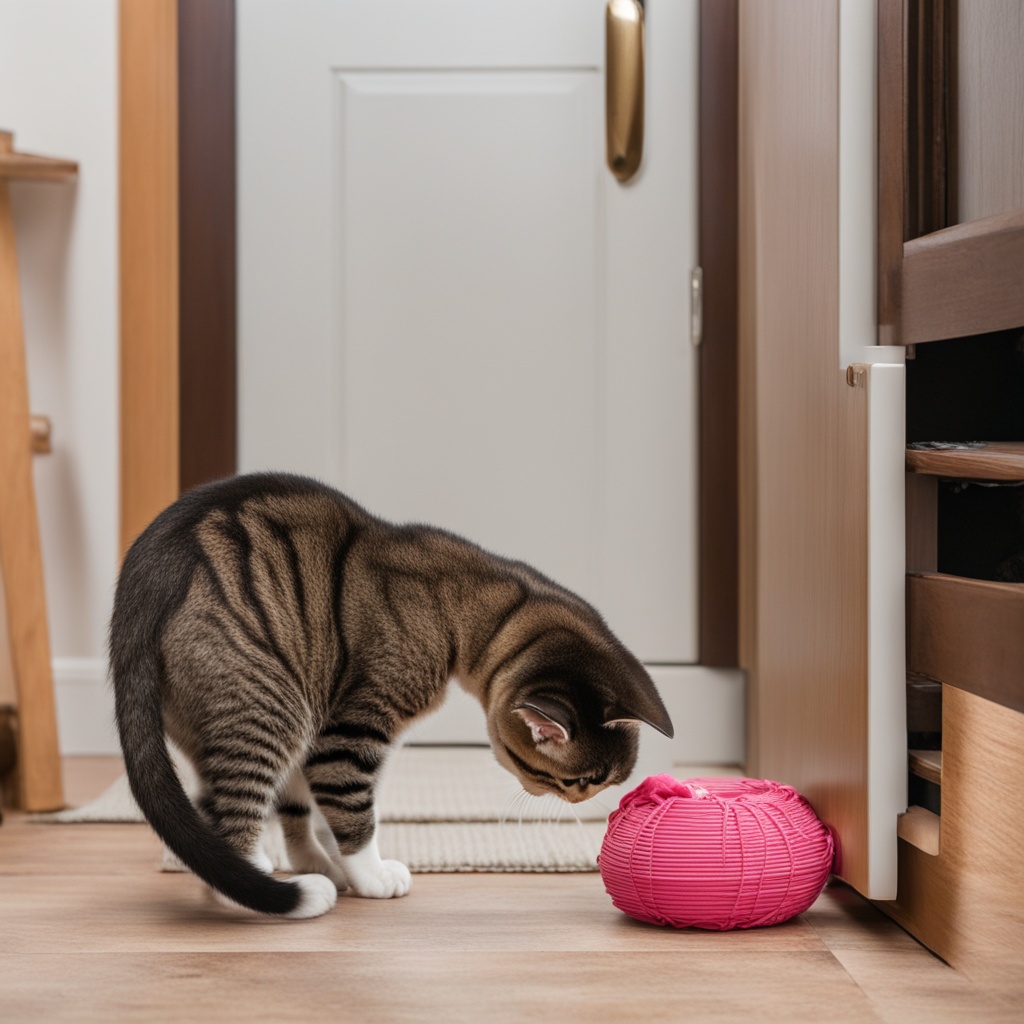
Welcoming a Scottish Fold into your home comes with its delights and quirks. When considering How to Train a Scottish Fold Cat to Use a Cat Door, it’s essential to remember the breed’s naturally inquisitive and adaptable nature. Providing indoor cats and cat doors may seem like the start of an epic adventure, but the benefits are well worth the effort, offering increased freedom and mental stimulation for your feline friend.
Scottish Fold cat training techniques are simple and effective, making the transition smoother for both you and your pet. Inspired by Bhim Solomon’s experiences, you’ll understand that naming your pet is just the beginning. Witnessing Moonpie’s tricks in London can inspire you to push your expectations and explore new training methods. As indoor cats adapt to cat doors, they gain access to a world of enriched environments, enhancing their overall well-being.
The journey of How to Train a Scottish Fold Cat to Use a Cat Door is not just about the destination but also about the process. By embracing Scottish Fold cat training techniques, you cultivate a bond built on trust and positive reinforcement, essential for successful training.
Understanding Scottish Fold Cat Behavior
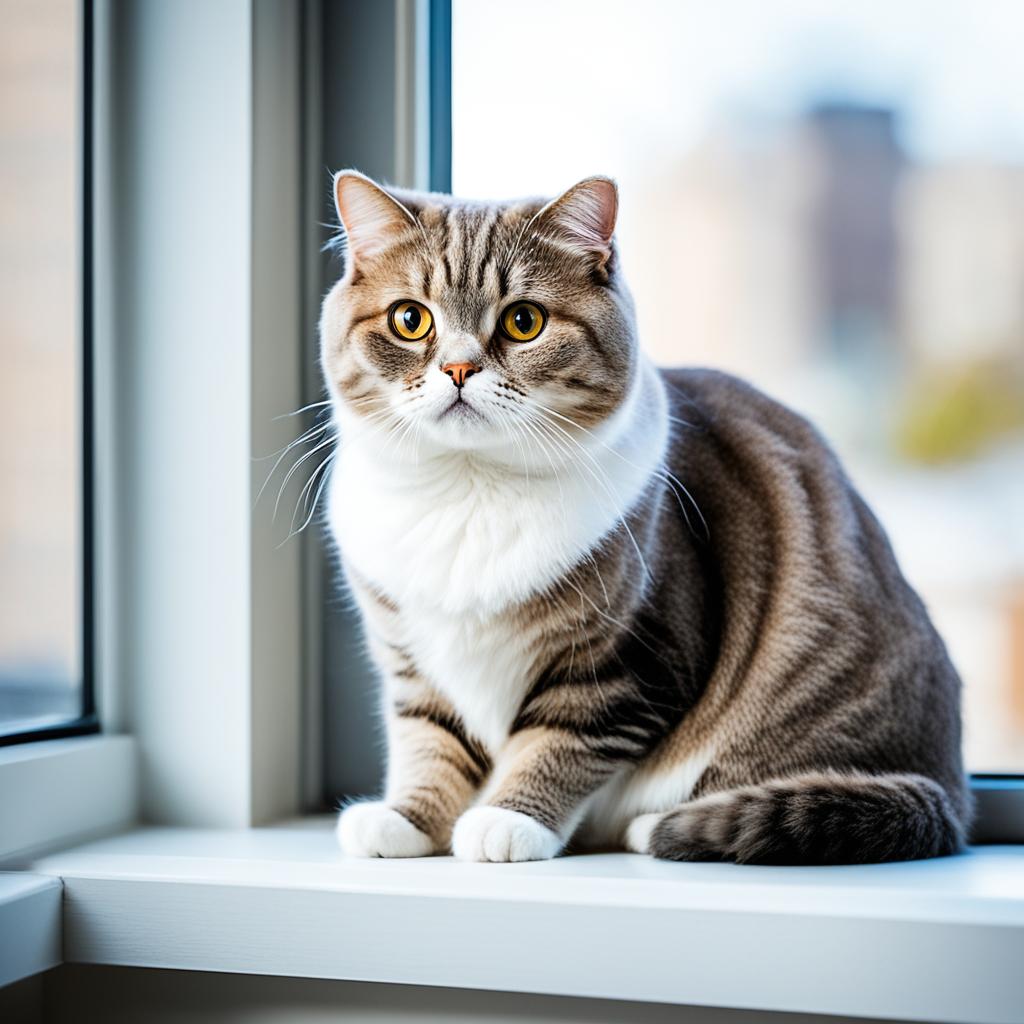
When it comes to Scottish Fold cat behavior, their unique traits and lovable quirks make them a favorite among feline enthusiasts. Known for their charming and owl-like ears, these cats possess a calm and placid demeanor that allows them to fit seamlessly into a range of households.
One standout feature of the breed is their remarkable adaptability. Whether you live in a bustling urban apartment or a quiet countryside home, the adaptability of Scottish Folds makes them well-suited to diverse environments. These felines thrive on regular interaction with their owners and require sufficient mental and physical stimulation.
Another endearing behavioral trait of Scottish Folds is their fondness for unique sleeping positions. Often, they may be spotted on their backs, legs skyward, which many owners find irresistibly cute. This behavior traces back to their genetic lineage, stemming from their barn cat ancestor, “Susie.”
Regular exercise and playful engagement are essential to maintain the health and wellbeing of your Scottish Fold. Given their intelligent and responsive nature, implementing training techniques such as using a cat door can be both rewarding and straightforward. These cats enjoy being included in daily activities and respond well to positive reinforcement.
Understanding these facets of Scottish Fold cat behavior helps reassure owners that with the right approach, fostering good habits like using a cat door can be a smooth process. Each Scottish Fold’s personality is distinct, yet their shared adaptability ensures they can excel in various aspects of training and family life.
Choosing the Right Cat Door for Your Scottish Fold
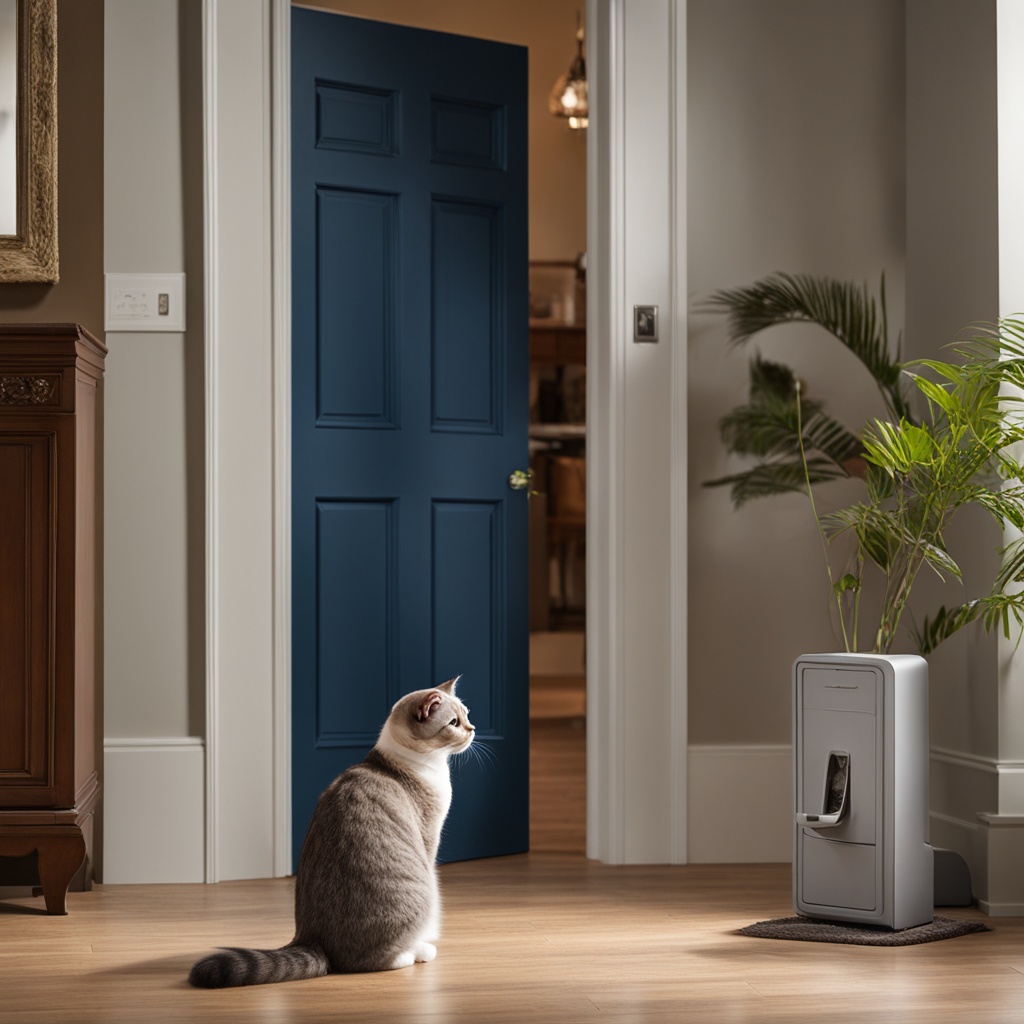
When it comes to choosing the proper cat door for your Scottish Fold, a variety of options are available. Whether you’re considering basic flap doors or more sophisticated solutions, making the right selection can significantly impact your feline’s comfort and accessibility.
Types of Cat Doors
There are several types of cat doors to consider, from the traditional flap to high-tech options. The Sure Petcare Microchip Cat Flap is a standout choice, particularly in multi-cat households. It reads your cat’s implanted microchip, ensuring only your pet has access, reducing the chances of local wildlife or neighborhood cats entering your home.
Size and Visibility Considerations
It’s crucial to get the cat door sizing right. The door should be large enough for your Scottish Fold to comfortably pass through but not so huge that it compromises household security. Ensure the cat flap is positioned at a height convenient for your pet, and consider adding a cat flap step if your feline friend requires a little extra help due to age or mobility issues. Visibility is also key—placing the cat door in a visible area ensures your cat can easily locate and use it.
Remember, the right door isn’t just about providing outside access; it’s about creating a safe and welcoming entryway that fits your Scottish Fold’s unique needs.
Steps to Train a Cat to Use a Cat Door
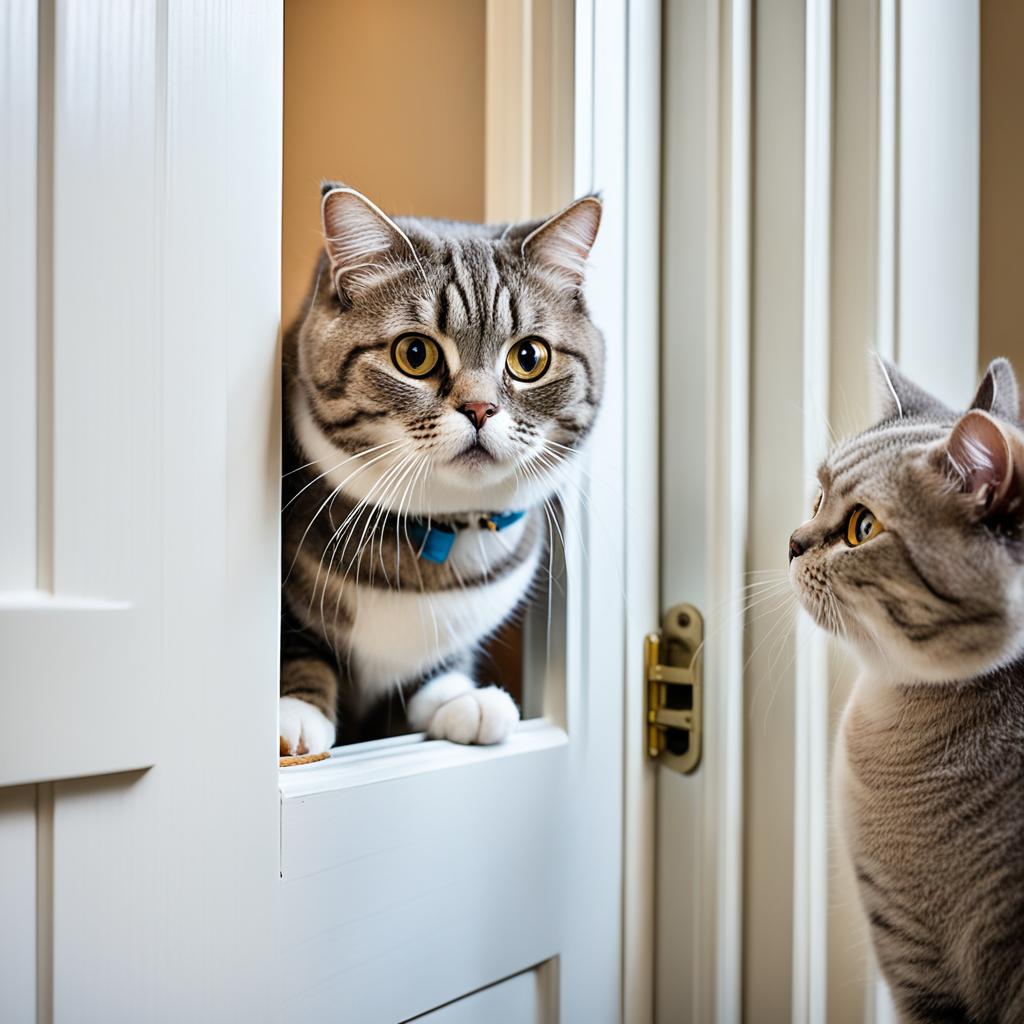
Training your Scottish Fold to confidently use a cat door can be a rewarding experience for both you and your feline friend. By following these steps to train a cat to use a cat door, you can ensure a smooth and successful transition. Remember that the key to a successful cat door training process lies in having consistent training sessions and ample patience.
- Introduce the Cat Door: Start by letting your cat explore the cat door while it’s fixed open, allowing them to become familiar with its presence.
- Remove the Flap: Temporarily take off the flap to make it less intimidating. This helps your cat to pass through without resistance.
- Use Treats: Place treats on the opposite side of the cat door to encourage exploration. This reinforces positive associations with the new entrance.
- Encourage Movement: Gently guide your cat through the door, using treats or toys as lures. Repeat this process to build confidence.
- Reintroduce the Flap: Once your cat is comfortably passing through, reattach the flap. Hold it open initially, then let it rest lightly against your cat.
“Maintaining consistent training sessions is fundamental for the cat door training process. Incremental practice and positive reinforcement create a seamless adaptation for your Scottish Fold.”
To make these steps more digestible and highlighted, here’s a simple table to summarize the cat door training process:
| Step | Description |
|---|---|
| Introduce the Cat Door | Let your cat explore the cat door while it’s open. |
| Remove the Flap | Take off the flap temporarily to remove any barriers. |
| Use Treats | Place treats on the other side to encourage exploration. |
| Encourage Movement | Guide your cat through using treats or toys. |
| Reintroduce the Flap | Reattach the flap and gradually get your cat used to it. |
Consistency and patience are crucial elements in the training experience. Stick to regular practice sessions, and soon your Scottish Fold will seamlessly integrate the cat door into their daily routine, enhancing their independence and your convenience.
How to Train a Scottish Fold Cat to Use a Cat Door?
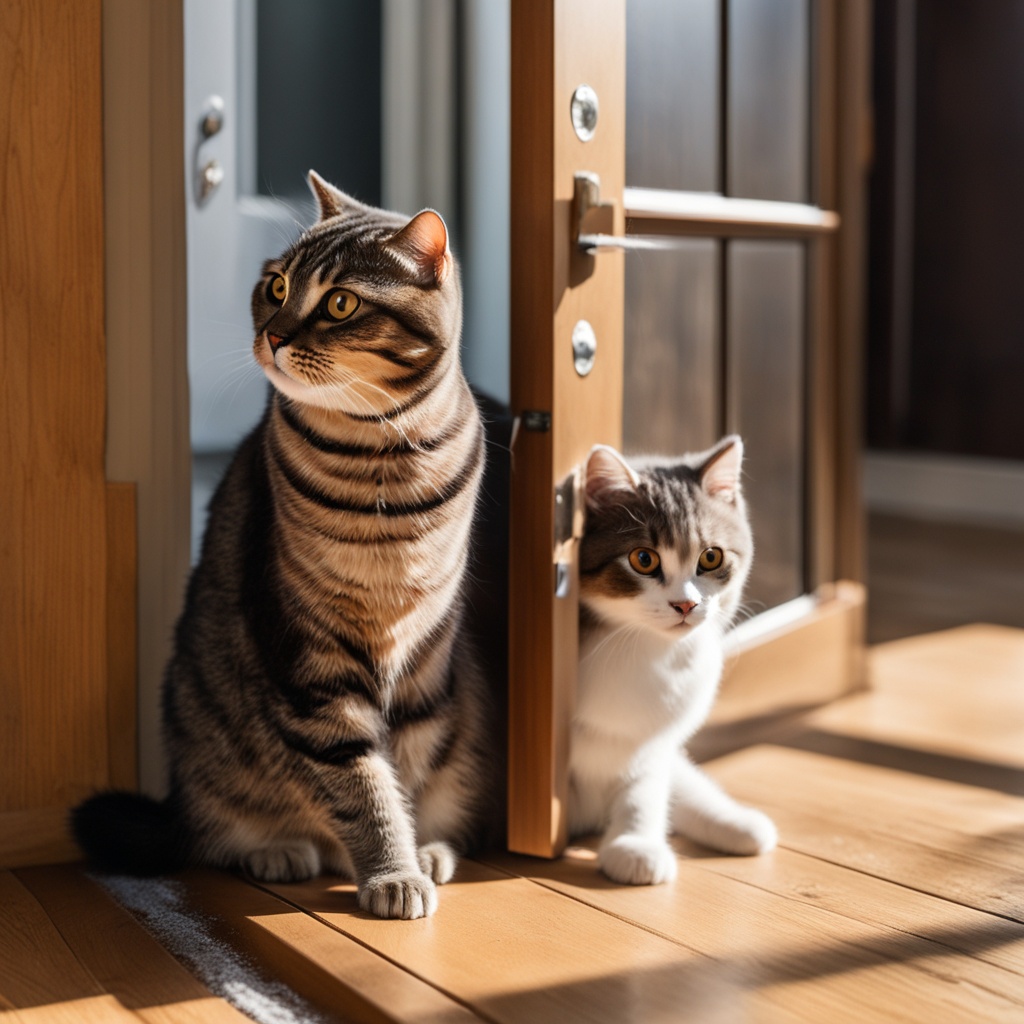
The process of training a cat to use a pet door involves understanding the unique quirks of your Scottish Fold. Since these kitties are known for their gentle demeanor, patience, and consistent practice are key. To kickstart your journey on how to train a Scottish Fold cat to use a cat door, begin by introducing the pet door in a calm and stress-free environment.
Use treats, catnip, or favorite toys as motivation for cat door use. Place them just outside the door to encourage your feline to investigate and eventually step through. Gradually, remove the pet door flap temporarily, allowing easy access, and let your Scottish Fold get accustomed to the new entrance-exit route without any obstructions.
- Start with encouraging gentle paw touches on the door
- Move on to rewarding partial entry through the door
- Eventually, use treats to entice full passage
Training a cat to use a pet door is a step-by-step process. Respect your cat’s pace and never rush the process. Scottish Folds are known for their adaptability but also enjoy their chill time. With patience and positive reinforcement, you’ll successfully learn how to train a Scottish Fold cat to use a cat door.
Remember, consistent practice is crucial. Allocate a few minutes each day for short training sessions, and gradually increase the duration as your Scottish Fold grows more comfortable. By doing so, you ensure a seamless, stress-free transition for your beloved pet.
Scottish Fold Cat Door Introduction Techniques
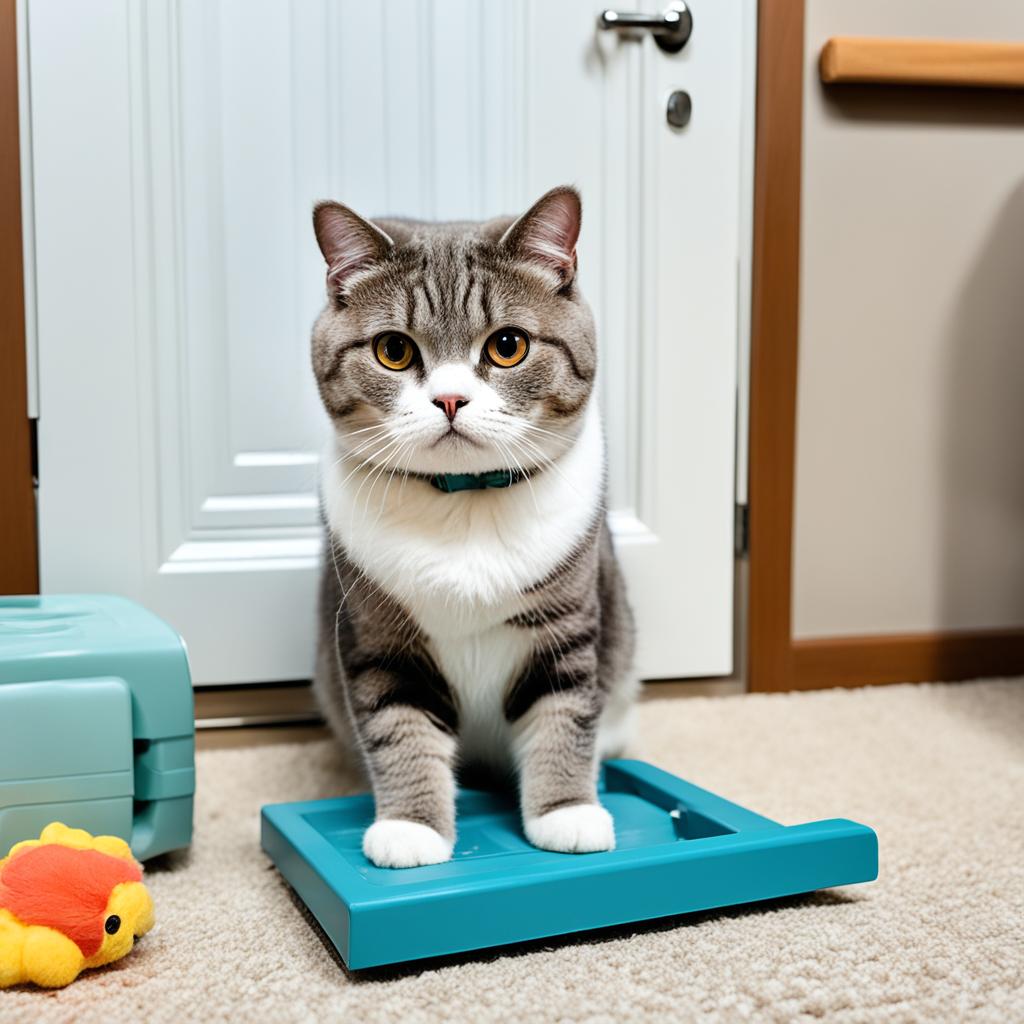
When introducing your Scottish Fold to a cat door, leveraging the right techniques ensures a smooth transition. Positive reinforcement in cat training is crucial to make the process enjoyable and effective. Let’s delve into some practical methods to get your feline friend comfortable with this new venture.
Positive Reinforcement
Positive reinforcement in cat training involves rewarding your cat for performing desired behaviors. When teaching cat door introduction techniques, start by letting your Scottish Fold explore the door at their own pace. Every time your cat shows curiosity, such as sniffing or touching the door, reward them with a treat or a gentle pat.
Another key aspect is consistency. Regular, positive interactions with the cat door help build familiarity. Utilize a calm and reassuring voice to create a comforting environment during training sessions. This method not only reduces stress but also makes learning an enjoyable experience for your cat.
Using Treats and Toys
Using treats to train cats can be one of the most effective cat door introduction techniques. Place a few treats near the door, gradually moving them closer to and eventually on the other side of the door. This encourages your Scottish Fold to pass through and associate the cat door with positive experiences.
Toys can also play a significant role. Hold a favorite toy on the opposite side of the door and encourage your cat to go through to fetch it. This not only makes training fun but also taps into their natural play instincts. Remember, using treats and toys not only motivates your cat but also makes the training sessions more interactive and engaging.
By integrating positive reinforcement in cat training, utilizing treats, and incorporating toys, you create a supportive and motivating environment for your Scottish Fold to learn and adapt to their new cat door. Monitoring stress signals, such as hesitance or displacement behaviors, ensures you can adjust the training pace accordingly, making the entire experience positive for your feline companion.
| Elements | Techniques | Benefits |
|---|---|---|
| Positive Reinforcement | Rewards for curiosity, regular interactions, calm reassurances | Reduces stress, makes learning enjoyable |
| Treats | Placing near, then beyond the door | Associates door with positive experiences |
| Toys | Use on opposite side, encourage play | Taps into play instincts, makes training interactive |
Training Tips and Tricks for Success
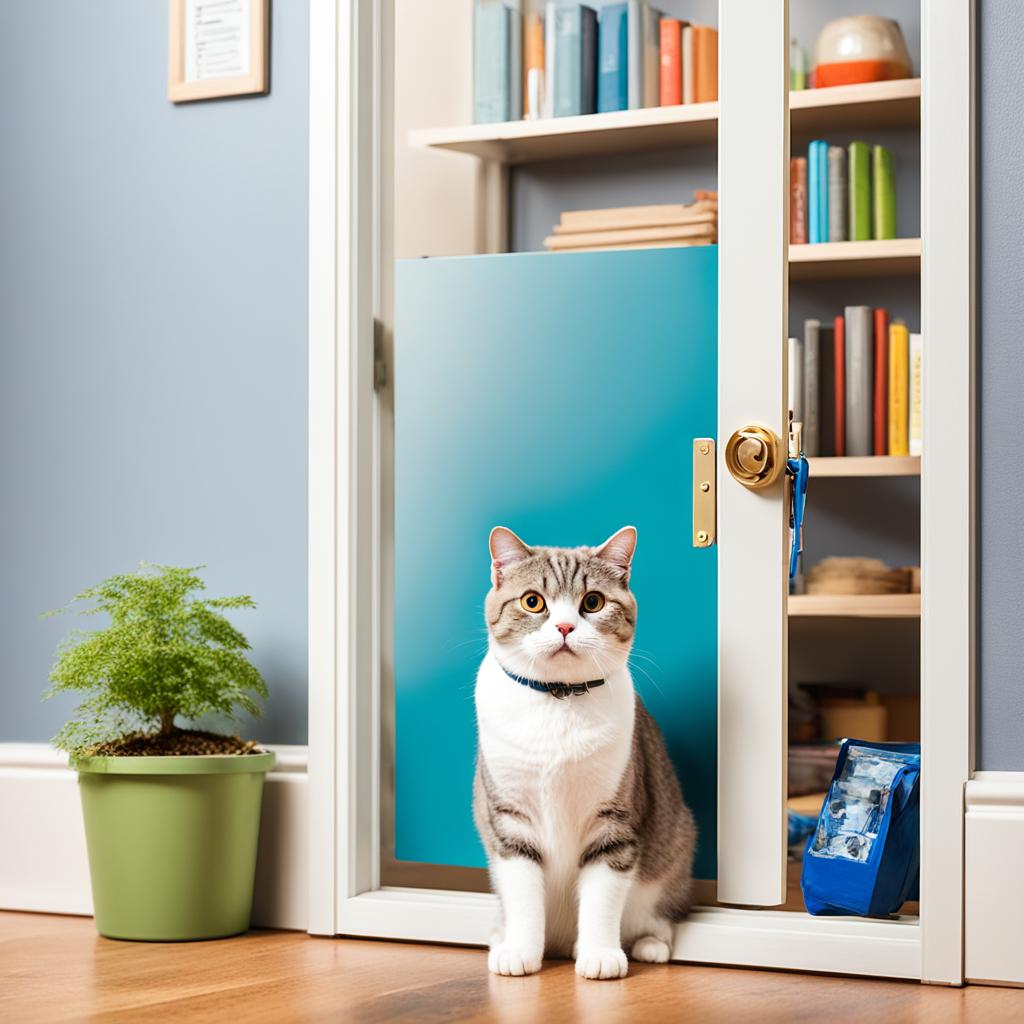
Training your Scottish Fold to use a cat door can be a rewarding experience with the right cat door training tips and tricks. Acclimating your cat to this new habit can be streamlined by adopting a reward-based training approach. This method not only encourages positive behavior but also helps in overcoming cat training challenges effectively.
First and foremost, using clicker training can be highly beneficial. Clickers help in marking specific behaviors that you want to reinforce, enabling your Scottish Fold to associate the sound with positive outcomes. Pairing this with treats will make each training session productive and fun for your furry friend.
Consistency is key when it comes to any training regimen. Brief and regular training sessions are vital as they prevent your cat from feeling overwhelmed. Overcoming cat training challenges often requires patience and a structured approach. If you notice signs of fatigue or disinterest, it’s better to take a break and try again later.
Understanding your cat’s body language is crucial during training. Cats communicate a lot through their body postures and facial expressions. For instance, a tail held high usually indicates confidence, while flattened ears might signal stress. By tuning into these cues, you can tailor your sessions accordingly, making use of reward-based training to encourage and reaffirm desirable behaviors.
To give you a more comprehensive outlook on how to adopt these strategies, here is a detailed comparison of different methods and their success rates:
| Training Method | Success Rate | Time Commitment |
|---|---|---|
| Clicker Training | 85% | Medium |
| Treat-Based Training | 80% | Low |
| Play and Toy-Based Training | 75% | High |
| Traditional Commands | 60% | Medium |
By integrating these cat door training tips and tricks, you’ll be setting up your Scottish Fold for success while making the process enjoyable for both of you. Remember, the combination of consistent training, understanding body language, and using positive reinforcement will help overcoming cat training challenges and lead to a happier, well-trained pet.
Common Challenges and How to Overcome Them
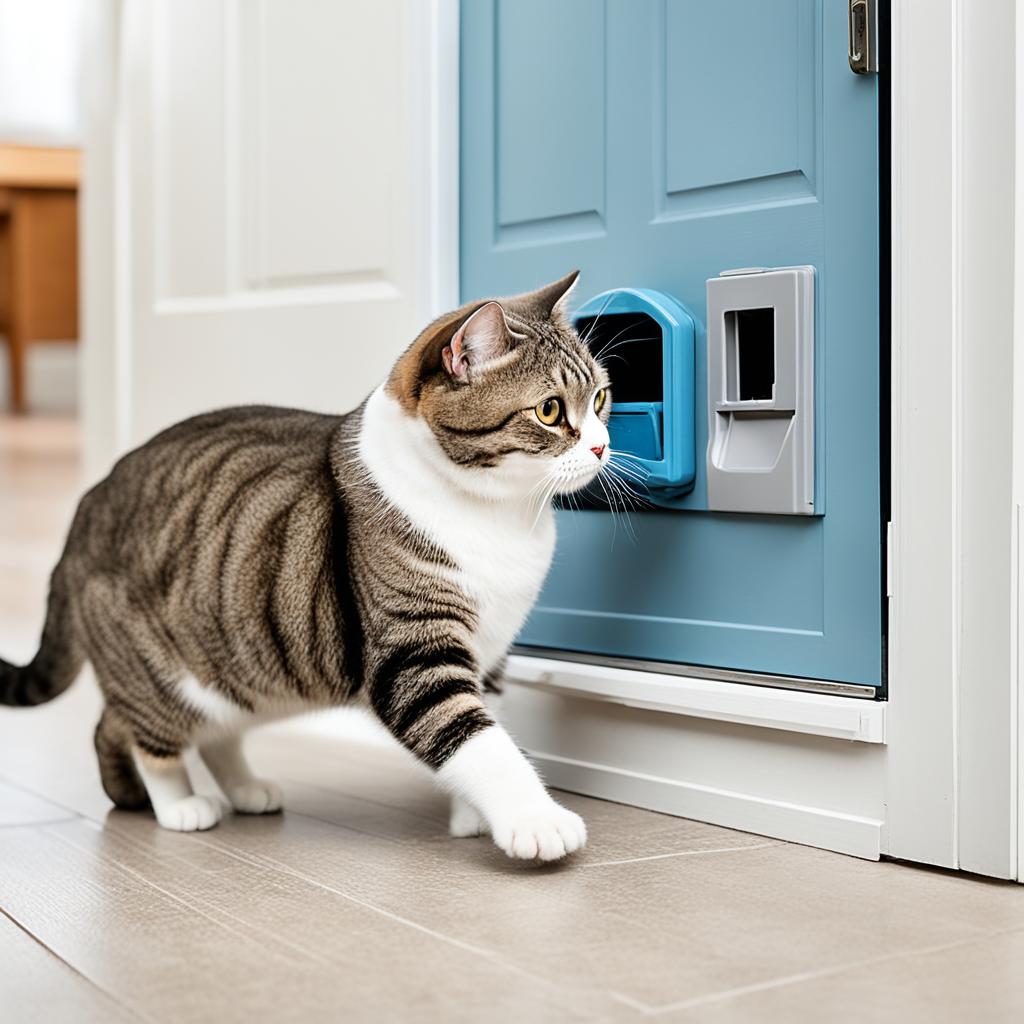
Training your Scottish Fold to use a cat door can indeed come with common cat training challenges. Fear of new experiences, anxiety, and the development of negative associations are typical hurdles. However, there are actionable tactics to ease these concerns and ensure a smoother transition.
One effective method to address these common cat training challenges is to remove the cat door flap temporarily. Replacing it with cling film offers a clear view while maintaining a barrier, reducing intimidation and easing cats into the idea of passing through. Gradually reintroducing the actual flap once your Scottish Fold shows comfort can make a world of difference.
Enhancing privacy around the cat door can also play a significant role in overcoming cat door fears. Consider placing potted plants near the door. This creates a more secluded and secure feeling environment, encouraging exploration without the looming fear of wide-open spaces.
To prevent negative experiences or the formation of a negative association with the cat door, it’s recommended to introduce new elements slowly and observe your cat’s reactions closely. Small steps, consistent reinforcement, and patience are the keys to ensuring your Scottish Fold can confidently embrace its newfound freedom.
For older or less agile cats, integrating ramps or cat-flap steps can assist in comfortable access, reducing the physical strain and fostering a positive approach towards the door.
- Swap cat door flap with cling film.
- Introduce potted plants for privacy.
- Use cat-flap steps for easier access.
By applying these strategies, you can effectively navigate the common cat training challenges associated with using a cat door, ensuring a pleasant and stress-free experience for your Scottish Fold.
Conclusion
In summary, successful cat door training brings a world of benefits both for you and your Scottish Fold. By fostering independent exploration, you enable your feline companion to enjoy the best of both indoor comfort and outdoor adventure. Embracing this newfound freedom strengthens their mental and physical well-being, making your cat’s life richer and more fulfilling.
The journey to lasting positive behavior starts with understanding your Scottish Fold’s unique needs and personality. Listening to their cues, offering patience, and employing positive reinforcement ensures that the training process becomes a bonding experience rather than a stressful task. Remember, every cat is different, and tailoring your approach to their individual pace and comfort level is the key to unlocking a harmonious partnership.
Ultimately, a properly trained cat door user embodies confidence and joy, transforming the dynamics of your household. Witnessing your Scottish Fold navigate their new door with ease and excitement is a rewarding testament to the effort and dedication poured into their training. Indeed, the goal is more than just mastering a skill—it’s about nurturing a confident, happy, and well-adjusted feline companion who thrives in their ability to explore independently.




